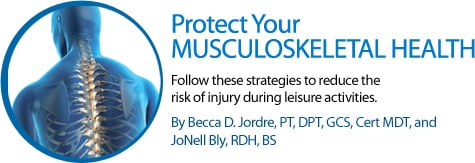
Protect Your Musculoskeletal Health
Strategies to reduce the risk of injury during off-work hours.
Each year about 70% of dental hygienists in the United States report musculoskeletal pain.1 Common problem areas include the neck, shoulders, back, wrist, and hands.2,3 While the practice of sound ergonomic strategies at work is essential for maintaining musculoskeletal health (see sidebar),4 little attention is paid to the effects of leisure activities.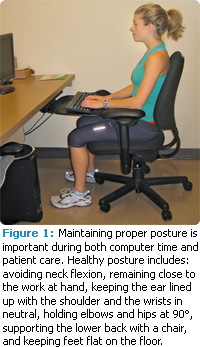
Working in an occupation that carries an increased risk of injury makes nonworking activity choices more critical. For example, many dental hygienists probably begin their day driving to work where they sit forward in their car seats, forget to use their lumbar support, and grip the steering wheel more than necessary. Patient care is then performed all day in a seated position that inevitably leads to more forward leaning. During lunch, they may lounge in a soft chair in the break room and scan their phone for new messages. At the end of their day, they may lean over their computer to catch up on email, and then finally curl up in bed to go to sleep. This scenario is concerning because nearly the entire day is spent in a forward flexed posture—a common postural dysfunction among dental hygienists.5 This poor posture greatly increases the risk of musculoskeletal pain, however, the risk can be diminished by adjusting the postures used during nonworking activities.
Computer Time
The postural demands of computer use are similar to those experienced during patient care (Figure 1). When determining the ideal posture for computer use, ergonomic goals for the work environment should be considered. In the operatory, neck flexion should be minimized via the use of properly adjusted loupes.6 At the computer, this is achieved by maintaining the monitor at eye level so that the top and bottom rows can be viewed without head movement. When the spine is neutral and upright, the shoulders should naturally fall in line below the ears. The elbows should be flexed approximately 90º and kept near the sides to reduce strain on neck musculature. Wrists should be maintained in a neutral position without significant flexion or extension to avoid compromising the carpal tunnel. Hips should be maintained at 90º or slightly more to keep the lumbar lordosis intact.7 Ideally, the side of each hip should line up with the shoulder and the ear. Feet should be maintained flat on the floor to assist with weight distribution. Maintaining this posture during any seated activity may decrease the likelihood of musculoskeletal injury.2,8,9
Sleep Posture
The body needs a break from the postures sustained at work, thus, sleep positioning can provide another opportunity to minimize injury. The best rule for a good sleep posture is to find one that does not cause nighttime waking and leaves you feeling refreshed in the morning.10
Lying on the back can be an excellent answer to a day spent in relative flexion.11 Finding a neutral position in supine means using only one pillow under the head10 and assuring that it is not too high.12 This helps prevent the forward head posture that is often used during dental interventions.5 A small pillow under the knees is also a good option for those experiencing low back strain during or after sustaining a prolonged supine position (Figure 2).13
 |
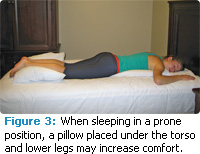 |
Sleeping in a prone position may create stress on the cervical spine because the neck remains significantly rotated—but it can be an excellent way to reverse the flexion of the low and mid back experienced during the workday.10 Positioning a pillow lengthwise under the torso can provide more room for the neck and protect the low back from lordosis. Another pillow under the ankles can support the lower legs in a comfortable position (Figure 3).13 The neck should be rotated to the position opposite of the direction most commonly used during the day.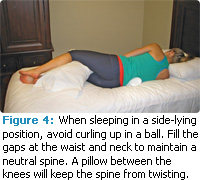
The side-lying position is probably the most popular sleep position, but it should be used carefully. For those who spend most of the day in a relatively flexed posture, the fetal position is risky. Sleeping consistently on the same side also promotes asymmetry that can lead to more musculoskeletal pain. In a side-lying posture, a neutral spine is still defined by a line connecting the ear to the lateral shoulder and hip. The gap between the waist and the surface of the bed should be filled with a small pillow or rolled towel.14 A pillow between the knees can assist in limiting trunk rotation and a medium-sized pillow under the head will keep the cervical spine from sidebending (Figure 4).
Drive Time
Proper posture while seated in a car is another important factor in reducing injury. Most car seats lack the adjustability needed to offer good ergonomics.15 Seats are low and the height is often not adjustable, potentially placing the lumber spine in excessive flexion. Holding the steering wheel causes tension in the upper extremities, which often places the driver in a forward leaning position that may mimic the working posture (Figure 5). Feet cannot be placed squarely on the floor because they are needed to operate the vehicle, thus limiting even weight distribution.
Adaptations are possible to reduce the risk of musculoskeletal injury. First, make sure the lumbar spine is supported.15 If the car has adjustable lumbar support, make sure it is positioned to fit your back, and then keep your back in contact with this support as much as possible. Lumbar supports can also be purchased or made from a towel or small pillow. Second, keep the seat back almost upright. A seat back angle of 100º will allow the most optimal position for the lumbar and cervical spine (Figure 6).15
Reaching forward to grasp the steering wheel can place excess strain on the neck and shoulders. Position the seat so you can reach the steering wheel while maintaining the elbows down by your sides. Armrests or small pillows placed under the elbows may help those who already have neck or shoulder pain.
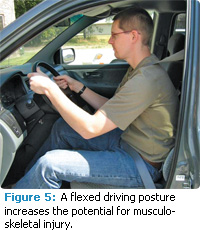 |
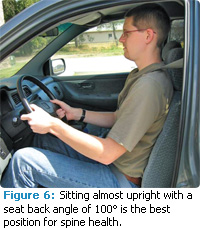 |
Exercise
Despite the appeal of collapsing on the couch after a long day at work, a heart-pumping exercise session can help decrease the likelihood of low back,16-18 neck,18 and shoulder pain.19 When considering what type of exercise to incorporate, think about the position of your body. Activities that position the body differently from typical work postures and encourage the body to move in the opposite and upright direction will help improve musculoskeletal health.2
Dental hygienists can enjoy long careers in clinical practice and maintain their health with fairly simple ergonomic interventions—both in practice and after work. From adding a lumbar support in the car and easing up on the steering wheel grip to trying a new sleep position, incorporating these strategies in after-work activities should improve musculoskeletal health.
References
- Osborn JB, Ne well KJ, Rudney JD, Stoltenberg JL. Musculoskeletal pain among Minnesota dental hygienists. J Dent Hyg. 1990;64:132-138.
- Lalumandier JA, McPhee SD, Parrott CB, Vendemia M. Musculoskeletal pain: prevalence, prevention, and differences among dental office personnel. Gen Dent. 2001;49:160-166.
- Anton D, Rosecrance J, Merlino L, Cook T. Prevalence of musculoskeletal symptoms and carpal tunnel syndrome among dental hygienists. Am J Ind Med. 2002;42:248-257.
- Dong H, Barr A, Loomer P, Laroche C , Young E, Rempel D. The effects of periodontal instrument handle design on hand muscle load and pinch force. J Am Dent Assoc. 2006;137:1123-1130.
- Marklin RW, Cherney K. Working postures of dentists and dental hygienists. J Calif Dent Assoc. 2005;33:133-136.
- Maillet JP, Millar AM, Burke JM, Maillet MA, Maillet WA, Neish NR. Effect of magnification loupes on dental hygiene student posture. J Dent Educ. Jan 2008;72:33-44.
- Saunders H, Saunders R. Evaluation, Treatment and Prevention of Musculoskeletal Disorders, Volume 1. 3rd ed. Chaska, Minn: Saunders Group; 1993.
- Rucker LM, Sunell S. Ergonomic risk factors associated with clinical dentistry. J Calif Dent Assoc. 2002;30:139-148.
- Horstman SW, Horstman BC, Horstman FS. Ergonomic risk factors associated with the practice of dental hygiene: a preliminary study. Professional Safety. 1997;42(4):49-53.
- McKenzie RA. The Cervical and Thoracic Spine Mechanical Diagnosis and Therapy. Waikanae, New Zealand: Spinal Publications; 1990.
- Hill S, Goldsmith J. Biomechanics and prevention of body shape distortion. Tizard Learning Disability Review. 2010;15(2):15-32.
- Persson L, Moritz U. Neck support pillows: a comparative study. J Manipulative Physiol Ther. May 1998;21:237-240.
- Minor M, Minor S. Patient Care Skills. 6th ed. Boston: Pearson; 2010.
- McKenzie RA. The Lumbar Spine. Waikanae, New Zealand: Spinal Publications; 1981.
- Harrison DD, Harrison SO, Croft AC, Harrison DE, Troyanovich SJ. Sitting biomechanics, part II: optimal car driver’s seat and optimal driver’s spinal model. J Manipulative Physiol Ther. 2000;23:37-47.
- Bigos SJ, Holland J, Holland C, Webster JS , Battie M, Malmgren JA. High-quality controlled trials on preventing episodes of back problems: systematic literature review in working-age adults. Spine J. 2009;9:147-168.
- Thiese MS, Hegmann KT, Garg A, Porucznik C , Behrens T. The predictive relationship of physical activity on the incidence of low back pain in an occupational cohort. J Occup Environ Med. 2011;53:364-371.
- Linton SJ, van Tulder MW. Preventive interventions for back and neck pain problems: what is the evidence? Spine (Phila Pa 1976). 2001;26:778-787.
- Miranda H, Viikari-Juntura E, Martikainen R, Takala EP, Riihimaki H. A prospective study of work related factors and physical exercise as predictors of shoulder pain. Occup Environ Med. 2001;58:528-534.
From Dimensions of Dental Hygiene. January 2012; 10(1): 30, 33-34.

